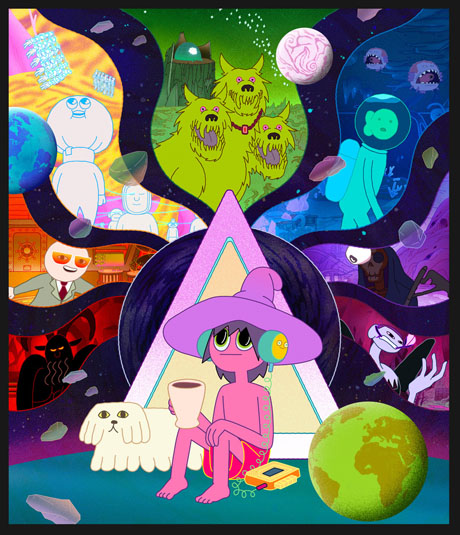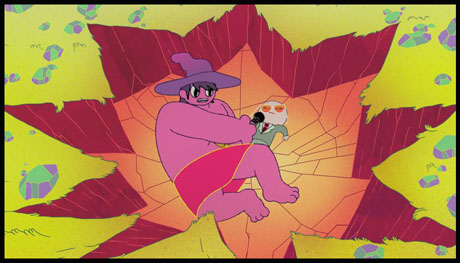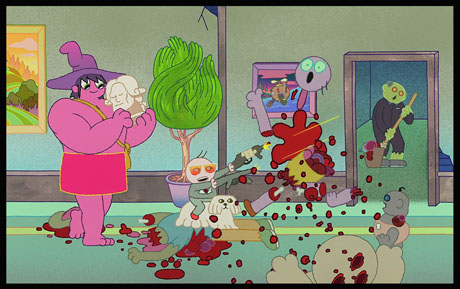
If you were wondering what Pendleton Ward has been up to since his cult hit Adventure Time aired its final episode, wonder no more. Ward has teamed up with podcaster Duncan Trussel to create The Midnight Gospel, a new animated series streaming on Netflix. All eight episodes extant are currently available. This is not your typical animated series, and rather than reviewing it as such, I would prefer to offer some thoughts on the show.
John Kricfalusi’s lasting legacy to American animation may be this insight: Within every creator of mainstream cartoons runs a strong desire to escape the constraints of networks and societal norms of broadcast standards. A great interview (or podcast!) would involve asking directors at Nickelodeon, Disney, or Cartoon Network (who aren’t involved with Adult Swim) what their shows would look like given free rein to push them as far as possible. Anything goes.

As far as Pen Ward is concerned, we have our answer. The Midnight Gospel is nominally about an otherworldly “spacecaster” named Clancy, a puce-colored, green-eyed humanoid with a signature hillbilly-style hat who lives in the Chromatic Ribbon. Through the use of a Universe Simulator, Clancy travels through space to conduct interviews with denizens of planets that are facing (or amidst) apocalyptic events. He simply picks a destination, transforms himself into a suitable avatar, and off he goes.
None of this matters in the least. The above is merely a framing device for the real content of the show, which is a deliberate attempt to distort the boundaries of our expectations. Ward directs and is responsible for the visual style of The Midnight Gospel. Here, he gets the chance to develop possibilities hinted at but very obvious in “Adventure Time”. Many episodes in that series featured soul-searching scripts, surreal turns, and characters that were surprisingly multifaceted. There were times that I, at least, sensed that Ward wanted to take some of his themes and ideas further. With all due respect to that sage dog Jake, the desire to slip the leash seemed evident.

Ward’s talent is balancing solid entertainment and characterization with thematic oddity, a big reason that Adventure Time was beloved by mature audiences. Still, Ward had to abide by the boundaries of what was, after all, a mainstream show. Teamed with Trussell, his liberation is on view for all to see in The Midnight Gospel. The show retains his artistic style from Adventure Time with a nod to Spider-Man: Into the Spider-Verse tossed in thanks to a winning job by Titmouse’s animation department. What’s new is the simultaneous breakdown between the narrative and the visuals, making The Midnight Gospel a very progressive concept.
Once Clancy gets to a world, and the interviews begin (Troxell’s forte), they frequently take on the nature of those deep, stoner discussions one might have with friends in a smoky college dorm room so easily parodied today. These calm, almost mundane conversations (or meditations), however, contrast with frenetic, violent, gory, or even mildly pornographic images occurring at the same time the storyline unfolds. “Trippy” is an understatement; this series should have been made in 1969 (although it could never have aired anywhere at that time). It would have been sublime viewing back then.

The Midnight Gospel is a dizzying, unique experience; Ward’s enthusiasm is evident, but be aware: this is a project that not only demands much from him and Trussell but from the audience as well.
Although Trussell and Ward, by their own accounts, have taken painstaking steps to coordinate the spacecast interviews with the visuals, it took me some time to fully appreciate the work they were doing; when I paid too much attention to the visuals and animation, I lost track of the conversation. When I attempted to follow the conversation, I found that I could not appreciate all of the details laid out in the animation. What I must understand is, nothing like this has been attempted before. Any enjoyment as I get from The Midnight Gospel is largely in my hands.
It is far different evaluating a film as opposed to an ongoing series; a movie, once released, is a finished product while an animated series evolves and refines itself over seasons—or even episodes in any given season. Thus, it is left to the viewer of The Midnight Gospel to integrate the initial dissonance into a whole. You may not experience a total gestalt after one episode, but practice makes perfect—or, in this case, fun. At best, this is a hit series that gains a following equal to Adventure Time. At the least, it is an unprecedented glimpse into the mind of a talented cartoon creator when all bets are off.
- ANIME REVIEW: “Lonely Castle in the Mirror” - September 24, 2023
- REVIEW: “Teenage Mutant Ninja Turtles: Mutant Mayhem - August 15, 2023
- REVIEW: “Spider-Man: Across The Spider-Verse” - June 7, 2023


 April 27th, 2020
April 27th, 2020  Martin Goodman
Martin Goodman  Posted in
Posted in  Tags:
Tags: 






